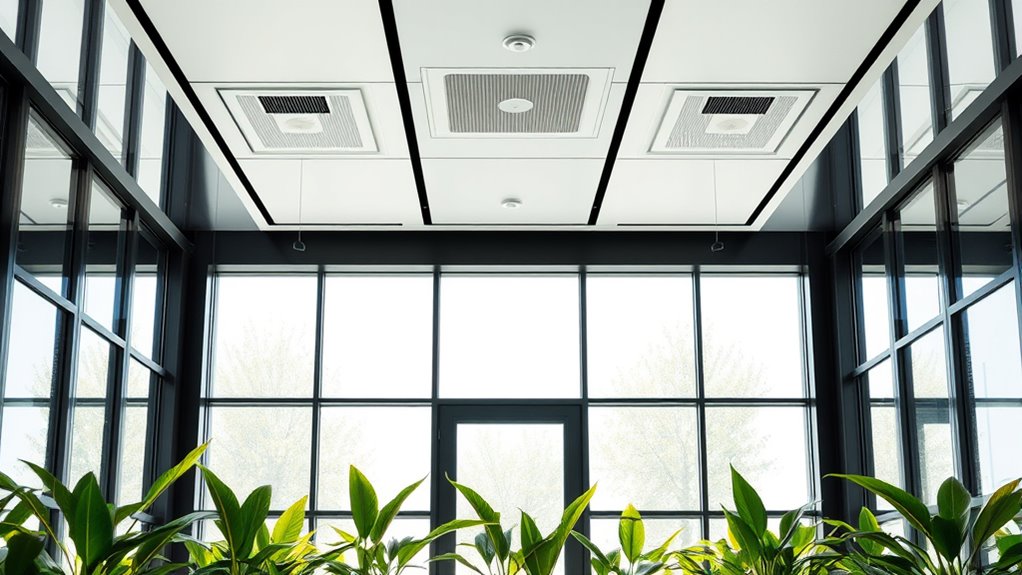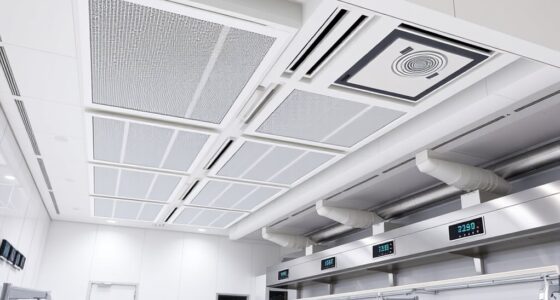In net-zero energy buildings, maintaining good indoor air quality is essential for your health and comfort. These airtight designs can trap pollutants from sources like paints, furniture, and appliances if not managed properly. You need proper ventilation systems, air filters, and low-emission materials to keep the air fresh and safe. Balancing energy efficiency with air quality may seem tricky, but understanding these strategies helps guarantee a healthier environment—explore further to learn how you can optimize your space.
Key Takeaways
- Proper ventilation and air filtration are essential to maintain indoor air quality while achieving net-zero energy goals.
- Selecting low-emission materials and furnishings reduces indoor chemical pollutants in airtight net-zero buildings.
- Mechanical ventilation systems must be carefully designed and maintained to ensure adequate outdoor air exchange.
- Managing humidity levels prevents mold growth and improves overall indoor air health.
- Regular assessment and adjustments balance energy efficiency with occupant health and indoor air quality standards.

Have you ever wondered how the air inside your home affects your health? Indoor air quality plays a vital role in your overall well-being, especially in net-zero energy buildings that aim for high efficiency and minimal environmental impact. These buildings are designed to reduce energy consumption, but if not managed properly, they can trap pollutants and compromise your health. That’s where understanding ventilation standards and pollutant sources becomes crucial.
Ventilation standards are guidelines set to ensure that indoor air remains fresh and safe. They specify the amount of outdoor air that needs to circulate within a space to dilute indoor pollutants effectively. In net-zero energy buildings, achieving these standards can be challenging because of their airtight design. While tight seals are essential for energy efficiency, they can also limit natural airflow, leading to poor indoor air quality if mechanical ventilation systems aren’t correctly installed or maintained. Proper ventilation is essential to prevent the buildup of pollutants like volatile organic compounds (VOCs), carbon dioxide, and moisture, all of which can cause health issues ranging from headaches to respiratory problems. Ensuring these standards are met means regularly assessing and adjusting ventilation systems to balance energy conservation with air freshness. You should pay close attention to the design and operation of these systems, making sure they bring in enough outdoor air and exhaust indoor air effectively. Additionally, air filtration systems can significantly improve indoor air quality by removing pollutants before they circulate.
Maintaining proper ventilation balances energy efficiency and indoor air quality in net-zero buildings.
Pollutant sources inside net-zero buildings can originate from various materials and activities. Common sources include adhesives, paints, cleaning supplies, and building furnishings, which emit VOCs over time. These chemicals can linger in the air and cause irritation, dizziness, or even long-term health effects. Additionally, indoor combustion sources like gas stoves or fireplaces release nitrogen dioxide and particulate matter, further degrading air quality. Humidity can also be a concern if ventilation isn’t adequate, as excess moisture promotes mold growth, which can trigger allergies and asthma. Even personal items such as electronics, carpets, and furniture can emit pollutants, adding to the indoor chemical load. Recognizing these sources is vital because it allows you to take proactive measures—selecting low-emission products, ensuring proper ventilation, and maintaining humidity levels—to keep indoor air safe. In net-zero buildings, integrating high-quality filtration and air exchange systems helps reduce these pollutant sources’ impact.
Ultimately, managing indoor air quality in net-zero energy buildings involves a careful balance. You need to uphold ventilation standards to ensure fresh air supply while minimizing pollutant sources. Regular maintenance, thoughtful material choices, and advanced ventilation strategies help you create a healthier indoor environment. By paying close attention to these factors, you can enjoy the benefits of a sustainable, energy-efficient building without sacrificing your health.
Frequently Asked Questions
How Do Indoor Air Quality Standards Differ for Net-Zero Buildings?
You’ll find that indoor air quality standards for net-zero buildings are more stringent, aiming to maintain healthier environments. You need to adhere to stricter indoor pollutant thresholds, reducing emissions from materials and systems. This means monitoring air quality more closely and using advanced filtration. By doing so, you guarantee that indoor air remains safe and comfortable, supporting the building’s energy efficiency goals without compromising occupant health.
What Innovative Technologies Improve IAQ in Energy-Efficient Buildings?
Imagine a gentle breeze guiding fresh air into your space; smart sensors and air purification systems work together to achieve this. These innovative technologies detect pollutants and adjust ventilation automatically, maintaining ideal indoor air quality. Smart sensors provide real-time data, while advanced air purification filters remove contaminants efficiently. Together, they create a healthier, more comfortable environment that aligns with energy-efficient goals, ensuring you breathe easier every day.
How Do Ventilation Systems Balance Energy Use and Air Quality?
You can balance energy use and air quality by optimizing ventilation systems with smart controls that adjust air exchange based on occupancy and air quality sensors. Incorporate advanced filtration systems to remove pollutants efficiently, reducing unnecessary energy consumption. By fine-tuning these systems, you guarantee fresh, healthy air inside while minimizing energy waste, creating a comfortable, sustainable environment without compromising air quality.
What Are the Challenges of Maintaining IAQ in Airtight Net-Zero Buildings?
You might think maintaining IAQ in airtight net-zero buildings is impossible, but it’s manageable with proper strategies. Humidity control prevents mold and discomfort, while addressing pollutant sources guarantees cleaner air. The challenge lies in balancing airtightness with ventilation needs; too tight, and you risk poor air quality, too loose, and energy efficiency suffers. By carefully designing systems, you can keep indoor air fresh without sacrificing energy goals.
How Does Occupant Behavior Impact Indoor Air Quality in These Buildings?
Your occupant habits considerably influence indoor air quality in net-zero energy buildings. Poor ventilation, frequent use of VOC-emitting products, or neglecting behavioral interventions can reduce air quality. By adopting good habits like regular window opening and minimizing pollutant sources, you enhance air quality. Behavioral interventions, such as education on proper ventilation techniques, empower you to maintain a healthier indoor environment, ensuring energy efficiency doesn’t compromise indoor air quality.
Conclusion
You prioritize clean air, you embrace sustainable design, and you create healthier indoor environments. You guarantee proper ventilation, control pollutants, and monitor air quality constantly. You design for energy efficiency, optimize indoor comfort, and support occupant well-being. In doing so, you build not just net-zero energy structures, but vibrant, breathable spaces. By balancing innovation with health, you pave the way for a future where indoor air quality and sustainability go hand in hand.









